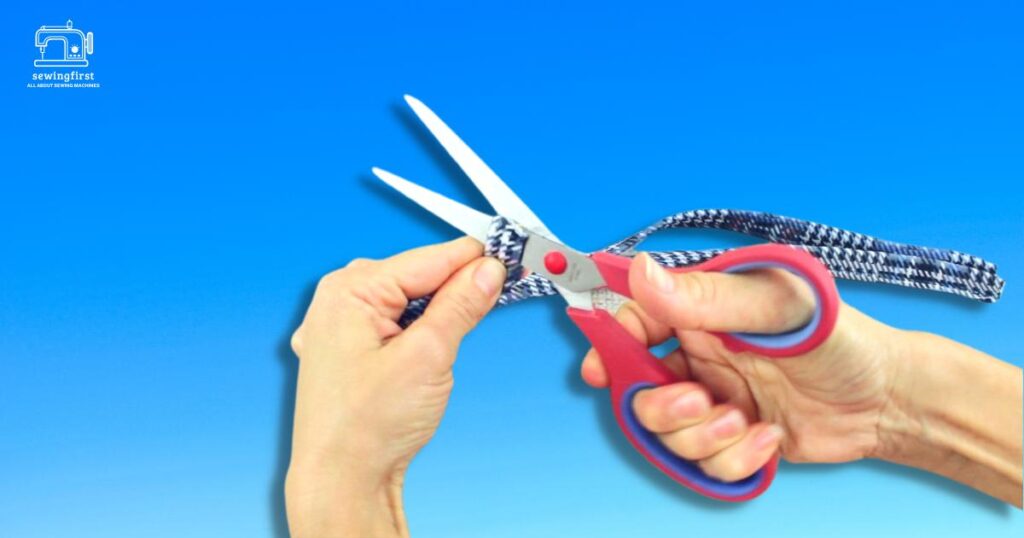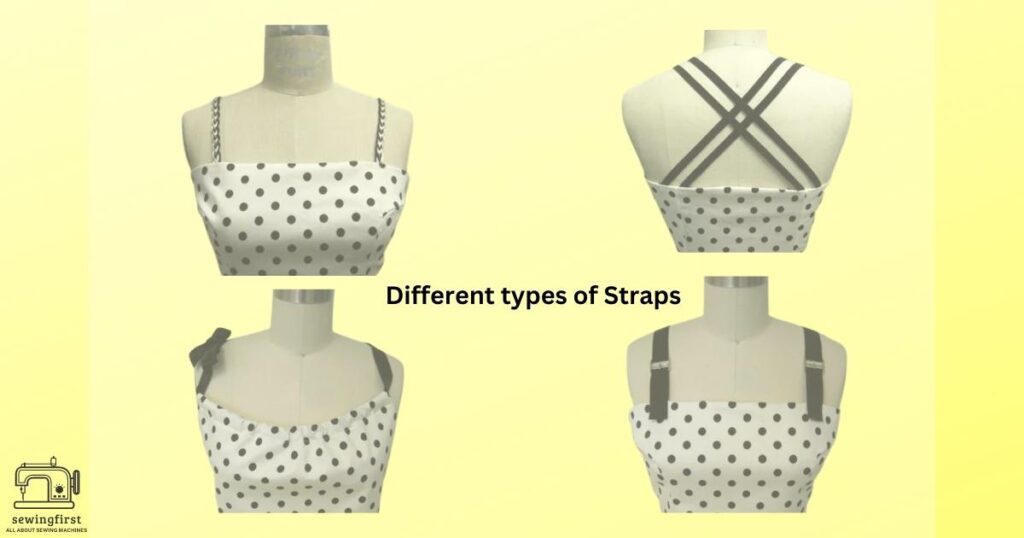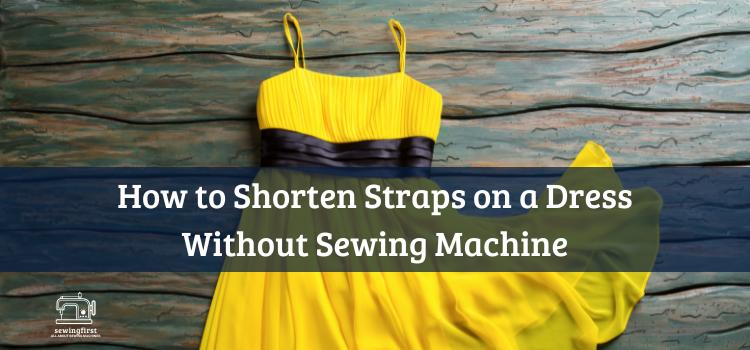When you buy a new dress, you usually get a size chart that tells you exactly where to cut the fabric. Unfortunately, most women don’t have access to a sewing machine, so they end up cutting the fabric themselves. This can result in uneven edges, frayed threads, and even tears.
In this guide, I’ll teach you how to shorten straps on a dress without sewing machine. All you need is scissors and a pair of sharp shears.
I’ll also show you how to make a quick and easy strap extender so you can wear dresses longer without worrying about fraying or tearing.
Related Topic: How To Tell If Your Sewing Machine Needle is Dull? Check This Before You Sew!
Table of Contents
ToggleThings You Need to Shorten Straps on a Dress
Shortening the straps of a dress or skirt isn’t difficult at all. In fact, you can do it yourself in just a few minutes. You only need the following:
- Scissors
- A pair of sharp shears (or a knife)
- An elastic band
- Thread
- Fabric glue
- Needle
Step 1: Cut Your Fabric
The first thing you want to do is cut your fabric into strips. The width of these strips should be equal to the length of the strap you are going to shorten. For example, if you’re shortening a long strap, then you would cut the fabric into two pieces. One piece would be twice as wide as the other.
If you’re shortening a shorter strap, then you’d only need one strip.
If you’re shortening a very long strap, then you may need more than one strip. In this case, you could use a ruler to measure the distance between each section of the strap. Then, cut the fabric accordingly.

Step 2: Fold It Up
Once you’ve cut your fabric into strips, fold it over itself by half its width. Make sure that the folded edge is aligned with the raw edge of the fabric.
Then, press down firmly on both sides of the fabric. This will help ensure that the fabric doesn’t fray when you start trimming off excess material.
use fabric glue to keep the fabric together while you’re working. Fabric glue works perfectly for hemming skirts and dresses.
Trim Off Excess Fabric
Once you’ve pressed down the fabric, take your scissors and carefully trim away any extra material from the top and bottom of the fabric.
This step is important because it ensures that there’s no extra bulk at the ends of the fabric. If you leave too much material, then it will bunch up and create an unsightly bulge.
Step 4: Cut Out the Strap
Now that you’ve trimmed off all the extra fabric, it’s time to cut out the actual strap. To do this, simply follow the guidelines provided by the manufacturer.
For example, if you’re making a dress, then you might find that the manufacturer has marked the exact location for the center back seam. That means that you should cut along the line indicated by the manufacturer.
Alternatively, if you’re shorting a skirt, then you might find the manufacturer has marked the hemline. That means that you would cut along the line indicated.
Step 5: Sew Back Together
After you’ve finished cutting out the strap, it’s time to sew it back together again. Start by folding the fabric back over itself.
Next, align the raw edges of the fabric and pin them together. Then, stitch through all three layers of fabric using a straight stitch.
Once you’ve sewn the strap back together, turn it inside out and press flat.
Step 6: Add Elastic Band
To secure the strap in place, you’ll need to add an elastic band. Simply cut a piece of elastic to fit around the strap.
Next, fold the elastic in half and lay it across the top of the strap. Pin it in place.
Finally, pull the ends of the elastic taut and tie them in a knot.
That’s it! You now have a new, shorter version of your favorite dress or skirt.
You can also make different types of shorts, skirts, dresses, etc. by following the same steps outlined above. Just remember to adjust the measurements according to what type of garment you’re creating.
Types Of Fabrics Before Shorten the Straps Of Your Dress
There are many different fabrics available today. Some are made of cotton, some are made of polyester, and others are made of silk.
However, regardless of which fabric you choose, you can always shorten the straps of your dress or skirt. The only difference is how you go about doing so.
Here are some common materials used to make dresses and skirts:
Cotton
Cotton is one of the most popular fabrics used to make clothing. It’s easy to work with, comfortable to wear, and affordable.
It’s also very durable. However, cotton tends to shrink as it dries. So, if you want to avoid having to re-hem your dress after wearing it, then you may want to consider another option.
Polyester
Polyester is a synthetic fiber that’s often used to make synthetic fabrics. It’s lightweight, strong, and cheap. But, like other synthetic fibers, it doesn’t breathe well. This means that it can get hot when worn.
Silk
Silk is a natural fiber that comes from the cocoon of the silkworm. It’s soft, luxurious, and expensive. Silk is usually reserved for high-end fashion items.
But, even though silk is expensive, you don’t have to worry about shrinking because it doesn’t dry out.
What About Other Materials?
While these are the most common fabrics used to make dresses and skirts, there are plenty of other options available. For example, you could use leather, vinyl, nylon, rayon, wool, or any other materials.
The important thing to keep in mind is that whatever material you choose, you should be able to easily shorten the straps of your favorite dress or outfit.
Lightweight fabrics such as cotton tend to stretch more than heavier ones. In fact, they’re almost impossible to shorten without adding weight to the fabric.
So, if you plan on making a dress or skirt out of something like cotton, you might want to consider buying a few extra yards of fabric. That way, you won’t have to hem the dress or skirt once you finish shortening it.
For Heavyweight fabrics, you’ll probably want to buy a little bit less fabric than you normally would. Otherwise, you risk stretching the fabric too much.
If you’re unsure whether or not you’ll be able to shorten the straps of your outfit, just ask someone who already owns the item. They’ll know exactly how long the straps are supposed to be.
And, if you do decide to shorten the straps of a dress or skirt, you’ll need to take into account the length of the straps before you start cutting them off. If you cut them too short, you’ll end up ruining the look of your dress or skirt!
Types Of Dresses with Straps
Dresses come in all shapes and sizes. There are short dresses, long dresses, strapless dresses, halter tops, empire waists, and more.
So, no matter what kind of dress you own, you can always shorten its straps. Here are just a few examples of the kinds of dresses you might find at your local department store.

Short Sleeve Dress
A short sleeve dress is typically sleeveless and has a V neckline.
Straight Skirt
A straight skirt is similar to a pair of pants. They’re typically longer than a pair of jeans. And they end right below the knee.
Halter Top
A halter top is similar to a tank top. It has a scooped neckline and two shoulder straps.
Empire Waist
An empire waist is similar to an A-line dress. It has a wide hemline and a V-neckline. It’s also known as a princess line dress.
Empire Waist With Pockets
An empire waist with pockets is similar to a pencil skirt. It has a wide bottom hemline and a V-neckline.
Long Dress
A long dress is similar to a maxi dress. It’s typically longer than a regular dress.
Skirt
A skirt is a piece of cloth that covers your legs. It’s typically shorter than a dress.
Flared Skirt
A flared skirt is similar to a mini skirt. It has a higher hemline and flares outwards.
Ruffle Skirt
A ruffle skirt is similar to a pinafore. It has a pleated hemline and ruffles around the edges.
How to seal fabric edges without sewing
There are many ways to seal the fabric edges. you can use fabric glue, spray starch, ironing, heat sealing, and more.
However, some people prefer to sew their seams instead of using any of those methods. If this sounds appealing to you, then read on.
1. Use Heat Sealing Tape
Heat-sealing tape is a great way to seal the fabric edges of your dress. You simply apply the tape directly over the seam. Then, press down firmly. The heat will melt the adhesive and create a permanent bond between the fabric.
2. Use Spray Starch
Spray starch is another option. You simply spray it onto the seam. Then, let it sit for several minutes before pressing down.
3. Iron Your Seams
You can also use an iron to seal the fabric edges together. Just place the iron over the seam. Press down firmly until the fabric sticks together.
4. Use Fabric Glue
Fabric glue is another option. You’ll need to cut off a small section from one side of the seam. Then, apply the glue to both sides of the fabric. Let it dry completely. Once it’s dry, fold the fabric back over itself and press down firmly.
5. Use Heat Sealers
If you don’t have access to a sewing machine, there are heat sealers available online. These tools work by melting the fabric together.
6. Use Hand Sewing
If you want to avoid using a sewing machine, you can hand-stitch the fabric together. This method works best if the fabric is thin enough. Otherwise, it may take too much time.
7. Use Elastic Band
Another option is to use elastic bands. Cut them into strips. Then, wrap each strip around the seam. Finally, tie the ends in knots.
8. Use Ribbon
Finally, you can use ribbon to seal the fabric edges instead of using any other method. Simply cut a length of ribbon equal to the width of the seam. Wrap it around the seam. Tie the ends in knots.
Types Of Straps for Your Dress
Straps are one of those things that seem simple enough until you actually try them out. There are many different types of straps for dresses, each with its own purpose. Here are some common types:
- The basic strap – This type of strap is usually used at the back of the neckline. They’re typically made of elastic material and come in various lengths.
- The shoulder strap – These straps attach to the shoulders and go over the top of the dress. They’re often worn with strapless dresses.
- The empire waist – This style of the strap attaches to the center front of the dress. They tend to be longer than the basic strap and may extend past the hemline.
- The halter – This style of strap goes across the chest and ties behind the neck. They’re commonly seen on cocktail dresses.
- The bow – This type of strap has two ends that tie together. One end is attached to the bodice and the other is tied to the skirt.
- The belt – Belts are great for adding structure to any outfit. They can be worn alone or combined with another piece of clothing.
- The sash – Sashes are similar to belts except they’re wider and shorter. They’re most commonly found on wedding gowns.
- The shawl collar – Shawls are long pieces of fabric that wrap around the neck. They’re typically worn with evening gowns.
- The bolero – Boleros are short jackets that cover the torso. They’re typically worn over a dress.
- The corset – Corsets are tight-fitting garments that cover the body. They were typically worn during Victorian times.
How to Shorten Straps on a Dress without Sewing Machine: Problems
While you might think that shortening your dress straps would make it easier to wear, this isn’t always true. In fact, it could cause problems. For example, when you shorten the straps of a dress, you’re likely to create an uneven fit. If you’re wearing a strapless dress, you may find that the straps aren’t as comfortable as they should be. And if you’ve got a dress with a high neckline, you may find that you can’t get the straps off easily.
Shortening the straps of a dress also makes it harder to walk comfortably. You’ll need to adjust the straps frequently so that they stay where you put them. It’s also more difficult to move your arms freely. So, if you’re planning to do anything active while wearing a dress, such as dancing or playing sports, you may want to leave the straps intact.
Shortening the straps of a garment will also affect how well it fits. The straps help keep the dress from slipping down. If you shorten the straps, the dress won’t have the same amount of support. This means that it may slip down and look sloppy.
Conclusion
If you want to shorten the straps of a garment, there are several ways to accomplish this. However, before you start cutting, you should know what kind of dress you’re working with. Then, you can choose which method works best for you.
FAQs
Is it possible to shorten a dress?
Yes, it is possible to shorten a dress. However, you don’t want to cut too much because it will ruin the shape of the dress. Instead, you should trim away some of the excess lengths.
In what ways can you shorten the waistline of a dress?
You can shorten the waistline of your dress by using elastic tape. Simply pull the tape up until the desired length is reached.
How can I measure the straps for my dress?
To determine how far apart the straps should be, use a measuring tape. Measure from one shoulder to the opposite shoulder.
What about the back of the dress? Can I shorten the back of the dress as well?
Yes, you can shorten the back of your dress. To do this, simply remove the zipper and then fold the material in half. Cut along the seam line.
Are the fabric straps are adjustable?
No, the fabric straps are not adjustable. However, you can add a belt to the dress to give it a more finished appearance.
Can I shorten the sleeves of a dress?
Yes. To shorten the sleeves of your dress, first, remove the sleeve headband. Next, cut the sleeve at the point where the arm meets the bodice. Finally, cut the sleeve into two equal parts.
How can I shorten the hemline of a dress? How can I shorten the hem of a skirt?
There are many different ways to shorten the hemline of your dress. One way is to use elastic tape. Another option is to sew a new hem onto the bottom edge of the dress.
How can I reduce the size of a dress?
The easiest way to reduce the size of a garment is to take it to a tailor. A professional tailor can alter any type of clothing. They can even shorten the sleeves of a jacket or change the hemline of a skirt.
How can I lengthen a dress?
The easiest way to lengthen a dress is to add a belt. You can either buy a new belt or attach an existing belt to the dress.





